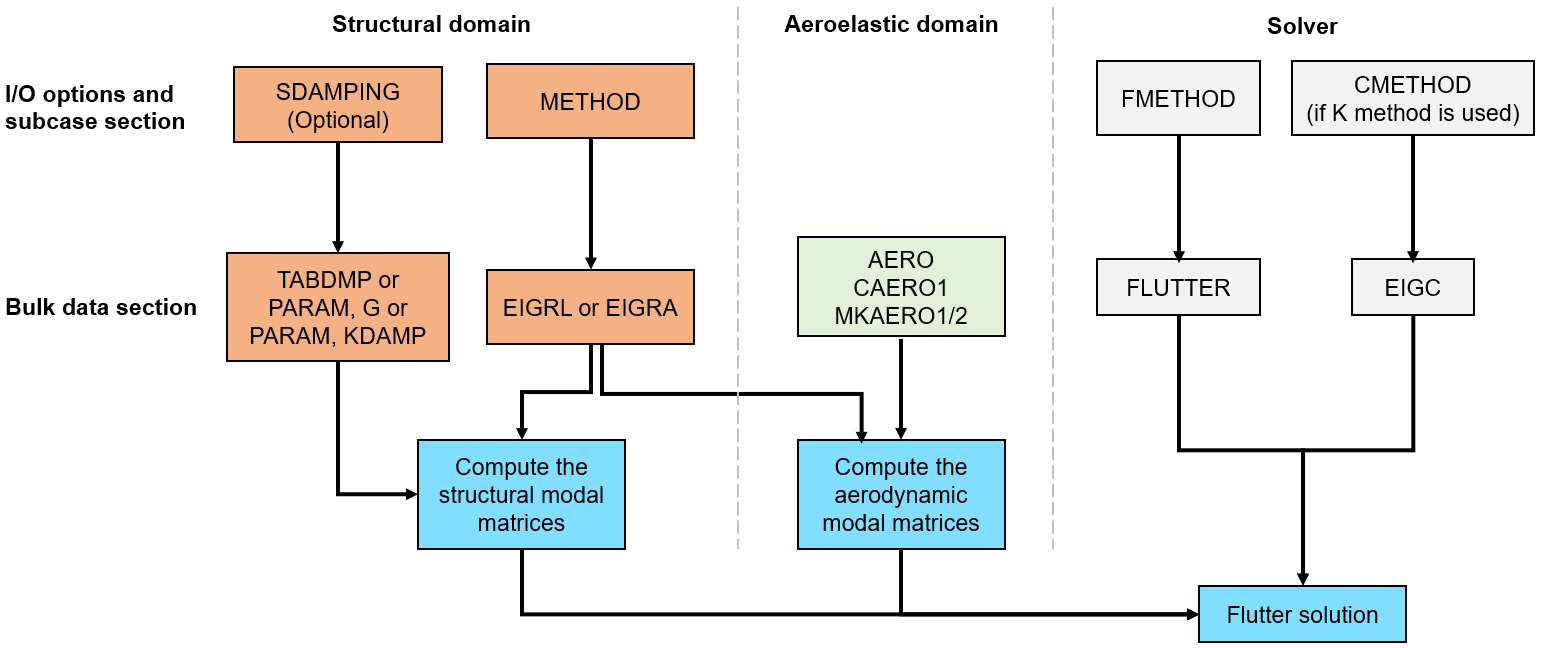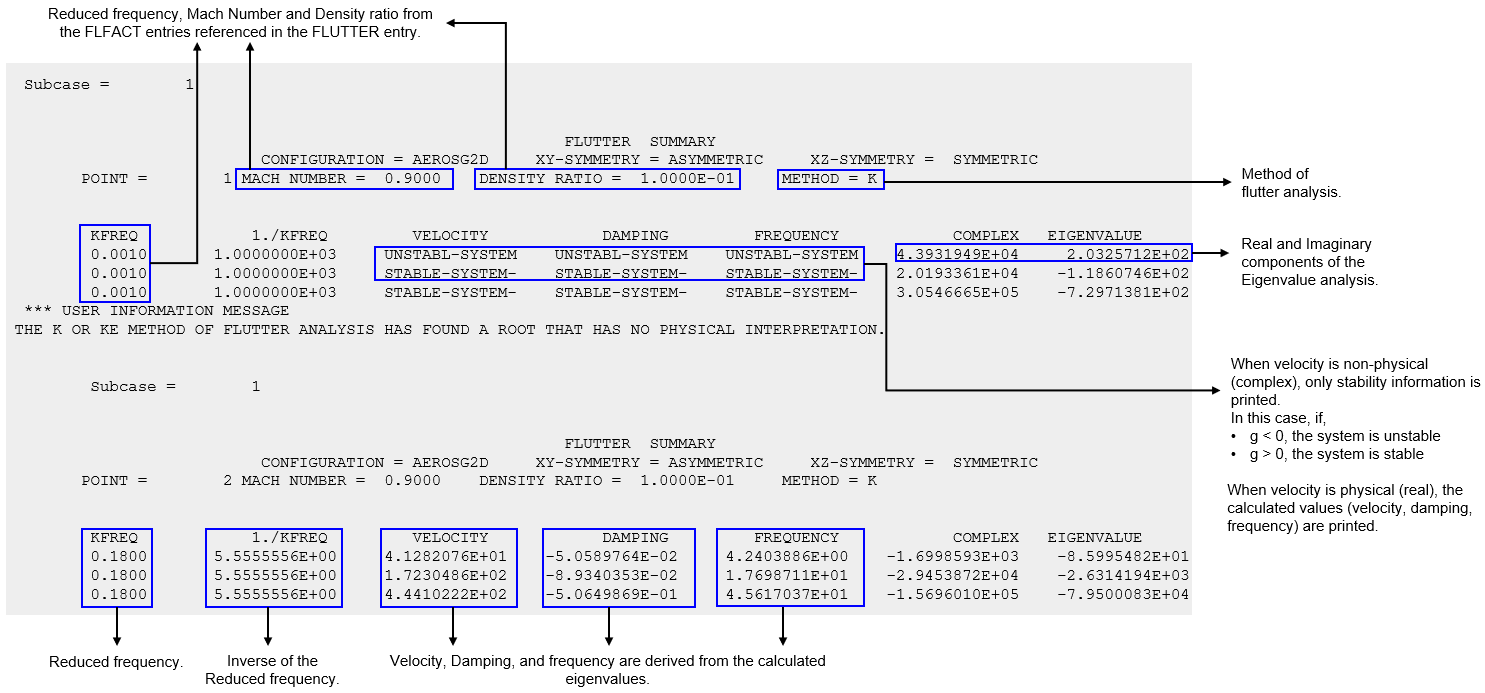Dynamic Aeroelastic Analysis
Dynamic Aeroelastic Analysis is the study of the deflection in flexible structures under aerodynamic loads, where the forces and acceleration are time dependent.
Flutter Analysis
Aeroelastic flutter is a dynamic instability of a structure associated with the interaction of aerodynamic, elastic, and inertial loads.
Flutter analysis of aeroelastic systems involves determining the velocity (and hence Mach Number) of the system and the frequency of oscillation at which the system attains the state of flutter. In this phenomenon, the aerodynamic loads on a flexible body couple with its natural modes of vibration to produce oscillatory motions with increasing amplitude.
This may lead to catastrophic structural failure. Therefore, structures exposed to aerodynamic loads must be carefully designed to avoid flutter.
In Finite Element Analysis, the prediction of flutter involves a series of complex eigenvalue solutions. OptiStruct uses the modal approach where the structural-vibration modes in a selected frequency range are used as the degrees of freedom.
Methods
The four different methods for flutter analysis supported in OptiStruct are K, KE, PK and PKNL.
For each of these methods described below, the complex eigenvalues ( ) are extracted for a particular case, from which the pairs of airspeed and damping ( - ), and airspeed and frequency ( - ) can be ascertained.
The precise form of eigenvalues differs for each of the methods.
- Transient decay rate coefficient.
- Circular frequency, given by .
- K Method:
- The philosophy behind the K method is to inject the system with artificial damping (in the form of a structural damping term) to push the system to the flutter point.
- A set of complex eigenvalues is output at every combination of density, Mach number, and reduced frequency from the FLFACT entries.
- For this reason, the results obtained from the K method are slightly difficult to interpret.
- KE Method:
- The KE method is a variant of the
K method with the following differences.
- The viscous damping terms are ignored.
- The complex modes are not output.
- The flutter output is arranged based on modes and sorted using an eigenvalue extrapolation technique.
- These features imply that the KE method is a computationally inexpensive and easy-to-interpret version of the K method.
- The KE method is a variant of the
K method with the following differences.
- PK Method:
- The PK method allows for a general flutter analysis to be performed using doublet lattice aerodynamics (that assumes simple harmonic motion) using an iterative process.
- In this method, the imaginary contributions to the stiffness matrix are ignored. This means that structural damping terms and modal damping with PARAM, KDAMP, -1 will not be taken into account.
- The eigenvalue extraction is carried out for every combination of density, Mach number, and velocity from the FLFACT entries.
- An initial guess of the reduced frequency ( ) is used to solve the complex eigen problem whose output returns an updated reduced frequency; the process being repeated until convergence. Modes are tracked across airspeeds using the left and right complex eigenvectors.
- PKNL Method:
- The PKNL method is a variant of the PK method designed with ‘no looping’.
- In this method, the number of entries in the FLFACT data for density ratios, Mach numbers, and velocities need to be the same and the eigenvalue extraction is carried out at each linear selection of density ratio, Mach number, and velocity.
- Scenario 1: The flutter analysis is carried out at the following points: (0.5, 0.3, 100), (0.5, 0.3, 200), (1.0, 0.3, 100), (1.0, 0.3, 200), (0.5, 0.4, 100), (0.5, 0.4, 200), (1.0, 0.4, 100) and (1.0, 0.4, 200).
$--1---><---2--><---3--><---4--><--5---><--6---><---7--><--8---><---9--> FLUTTER 103 PK 1 2 3 L 4 FLFACT 1 0.5 1.0 FLFACT 2 0.3 0.4 FLFACT 3 100.0 200.0 - Scenario 2: The flutter analysis is carried out at the following points: (0.5, 0.3, 100) and (1.0, 0.4, 200).
$--1---><---2--><---3--><---4--><--5---><--6---><---7--><--8---><---9--> FLUTTER 103 PKNL 1 2 3 L 4 FLFACT 1 0.5 1.0 FLFACT 2 0.3 0.4 FLFACT 3 100.0 200.0
Input

Figure 1. Flutter analysis work flow
| Entry | Description |
|---|---|
| AERO | Defines flight conditions. |
| MKAERO1/MKAERO2 | Specifies the Mach number and reduced frequency pairs for the explicit computation of the aerodynamic matrix. |
| FLFACT | Specifies the values of flutter parameters (Density ratios, velocities, and reduced frequencies) for flutter analysis. |
| FLUTTER | Selects the method (K/KE/PK/PKNL) and parameters for flutter analysis. This entry also references the definitions of FLFACT. |
| EIGC | Selects the complex eigenvalue method for the K method. |
| EIGRL/EIGRA |
|
| PARAM, VREF | Used to scale the output velocity: Vout = V/Vref. |
| DMI | Defines real matrix data blocks. |
Problem Setup
$ ************************************************************
$ SNIPPET OF AN INPUT FILE FOR AEROELASTIC FLUTTER ANALYSIS
$ ************************************************************
DISP = ALL
SUBCASE 101
SPC = 101
METHOD = 102
FMETHOD = 103
BEGIN BULK
$--1---><--2---><--3---><--4---><--5---><--6---><--7---><--8---><--9---><--10-->
EIGRL 1 0.0 100. 4 MASS
FLUTTER 103 PK 1 2 3
FLFACT 1 0.4
FLFACT 2 0.5
FLFACT 3 150 -175 -200
$ If there are certain velocities for which flutter eigenvector output is desired,
$ in PK/PKNL methods, a negative sign can be added as shown above. In this example,
$ output to the result file will be available only for the velocities: 175 and 200.
$ See Output Section for more details.
AERO 102890. 2200. .123E-110 0
MKAERO1 0.5
+ .001 0.002 0.005 0.01 0.05 0.1 0.2 0.3
MKAERO1 0.5
0.5 0.6 0.8 1.0 1.5 2.0 3.0 4.0
$ other aeroelastic and structural entriesOutput
- Flutter Analysis Summary
- The roots of the Complex Eigenvalue Analysis are printed in the .flt file. A typical flutter analysis summary in the
.flt file is shown below.

Figure 2. Flutter analysis summary in an example .flt file - H3D Output
- Currently, only the following output requests are supported with flutter
analysis. Refer to Aeroelastic Flutter Analysis for supported output formats.
- DISPLACEMENT
- SDISPLACEMENT - available only for K, PK and PKNL methods